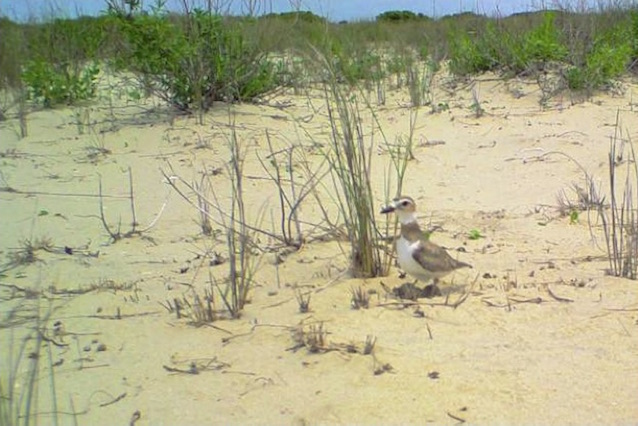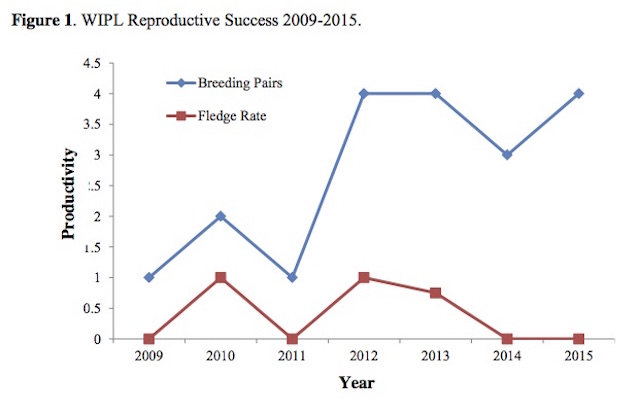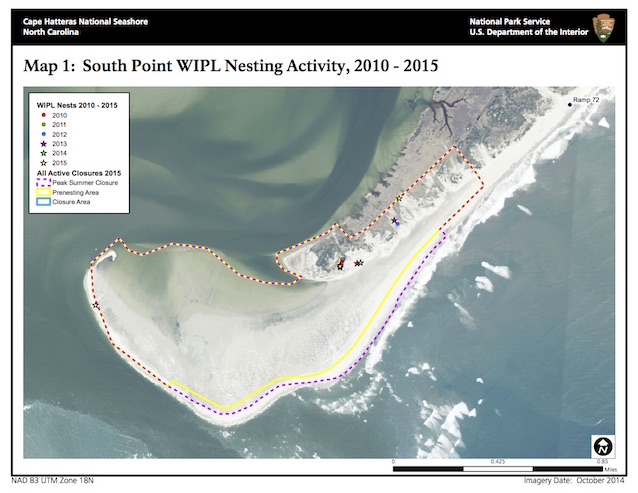Plover monitoring began at Cape Hatteras National Seashore in 1985 and the first Wilson’s plover nest was documented in 2009. Monitoring has focused on identifying nesting habitat, locating and protecting WIPL breeding territories and nests, and determining nest and brood success. This report contains a summary of monitoring results for the 2015 breeding season.

National Park Service
Introduction
The WIPL is a ground-nesting shorebird native to North Carolina. The preferred nesting habitat is vulnerable to destruction from development, erosion, and weather events (tropical storms, extreme high tides). Disturbance from recreational activities can cause plovers to abandon their nests leaving their eggs exposed to predation and overheating. The WIPL is listed as a Species of Special Concern in North Carolina.
Wilson’s plovers generally lay two to three eggs in a small, shallow depression or scrape. The pair can take up to five days from the laying of the first egg to completion of the clutch (Bergstrom 1988). Upon completion of the clutch, the pair incubates the nest for 23-27 days until hatching. Both the eggs and chicks are cryptic in coloration which makes them difficult to locate. Chicks are precocial and follow the adults to locations where they forage for crustaceans, particularly fiddler crabs, and insects found in and on the sand.
ORV Management Plan
On February 15, 2012 the ORV Management Plan was enacted at CAHA. It was developed from 2007-2012 and was accompanied by a special regulation detailing requirements for ORV use at CAHA. A copy of the ORV Management Plan and other related documents are available electronically at https://parkplanning.nps.gov/caha. It includes establishment of an ORV permit system to drive on CAHA beaches. It also establishes pre-nesting closures and buffer requirements for nesting birds and chicks. This was the third year the ORV Management Plan guided the management of protected species at CAHA.
Methods
Closures
Pre-nesting closures were installed in areas where the habitat was suitable for nesting and where nesting has occurred in more than one of the past five years. As per the ORV Management Plan, WIPL require a 75-meter buffer for breeding activity, scrapes and nests and a 200-meter buffer for unfledged chicks. When multiple species were present, the greatest applicable buffer distance was used.
While pre-nesting closures minimize disturbance in potential breeding areas, they also enable birds to establish territories and nest in their preferred habitat. An annual habitat evaluation was conducted from February 16 - February 27, 2015, prior to the onset of the breeding season. This evaluation, along with maps of historic nesting locations, was used to determine the boundaries for the pre-nesting closures (Appendix A, Maps 1-3).
Monitoring
Field staff began monitoring for WIPL arrival and breeding behavior in early March. After a nest was located, a predator exclosure was installed when the nest contained three eggs. Thereafter, the nest was briefly approached weekly to inspect the exclosure, verify the number of eggs, and check for predator tracks. The nests were also monitored daily, from a distance, to document incubation, nest abandonment, and/or to detect other potential problems. Due to the alert and protective nature of WIPL adults, the pairs were rarely observed incubating but were documented outside the exclosure. Observation times were minimized to reduce disturbance to the nesting pair.
After hatching staff attempted to monitor the broods daily, though this proved to be a difficult task. Adult WIPL prefer to forage with their chicks in vegetated intertidal mudflats where the chicks can easily be concealed for safety. Broods were assumed to be in areas where adult WIPL were documented being territorial with other shorebirds. In accordance with the ORV Management Plan, chicks were considered fledged at 35 days of age or when observed in sustained flight of at least 15 meters
Predator Exclosures
Predator exclosures have been used at CAHA since 1994 to reduce impacts from predators on nesting plovers. Exclosures are circular in shape (roughly ten feet in diameter), made of two inch by four inch welded-wire fence anchored by steel rebar and topped with a three-quarter inch mesh bird netting. Exclosures were installed following the guidelines established in the USFWS’ Piping Plover Recovery Plan (USFWS 1996, Appendix F).
Predator Control
Mammalian predation is a major factor in shorebird nest loss and chick mortality at CAHA. Predator control is conducted to target predators near nests and chicks. Trapping was not conducted in all park districts during the 2015 season.
Results
In 2015, four WIPL pairs and three nests were identified. All nests were found on South Point, Ocracoke Island. One of the three nests hatched and produced a maximum of three chicks. A WIPL brood was observed with one chick on June 21, 2015 from an undetected nest. Due to the evasive behavior and mobility of the broods, an exact number of chicks hatched is unknown. No chicks were fledged (Table 1). The earliest nest was discovered on April 25, 2015 and the latest nest was found on May 31, 2015. The average time to hatch was 26 days.
Since 2009, six pairs of WIPL fledged nine chicks which represents a 0.67 fledge rate per pair (Figure 1). The average time to fledge for the three broods with known fledge dates was 28 days. Three of the six broods were not observed with fledged chicks until more than 35 days after hatching.
Table 1. Summary of WIPL Reproductive Success 2009 – 2015
|
Year |
Breeding Pairs |
Total Nests |
Nests Hatched |
Successful Pairs (at least 1 chick fledged) |
Number of Chicks Fledged |
Fledge Rate |
|
2009 |
1 |
1 |
1 |
0 |
0 |
0 |
|
2010 |
2 |
2 |
2 |
1 |
2 |
1.0 |
|
2011 |
1 |
1 |
1 |
0 |
0 |
0 |
|
2012 |
4 |
4 |
2 |
2 |
4 |
1.0 |
|
2013 |
4 |
4 |
3 |
3 |
3 |
0.75 |
|
2014 |
3 |
3 |
2 |
0 |
0 |
0 |
|
2015 |
3 |
3 |
2 |
0 |
0 |
0 |

Nest Failures and Chick Mortality
In 2015, one WIPL nest was lost to mink predation and one WIPL nest was lost to an unknown cause. Of the four chicks assumed to be hatched, all were lost prior to fledging and all losses were attributed to unknown causes. Determining the cause of chick mortality is difficult due to the tendency of WIPL broods to spend most of their time within vegetation. Mammalian, ghost crab and avian predators are believed to be responsible for the losses.
Human Disturbance
Human disturbance, direct or indirect, can lead to the abandonment of nests or loss of chicks. Throughout the season, resource management staff documented 210 pedestrian, 13 ORV, and 29 dog, boat or horse intrusions in resource closures. It is important to note that most of the closures contained multiple species, including least terns, American oystercatchers, and piping plovers. Most illegal entries were not witnessed, but documented based on vehicle, pedestrian, or dog tracks left in the sand. Pedestrian entry into a closure most often required visitors to lift or stoop under the string that connected all posted signs, while vehicular entry required visitors to drive through or around a sign boundary. Disturbance was not documented to be a major factor for the loss of nests or chicks during the 2015 breeding season.
Banded WIPL
While CAHA does not participate in banding WIPL, there are several projects throughout the southeastern United States banding WIPL with unique color band combinations. Scientists study the banded birds to gain a better understand of movement patterns related to migration, nesting, wintering, foraging, etc. Since 2012, there have been nine individual WIPL with color bands observed at CAHA. Five individuals have been attributed to four separate nests at CAHA since 2012. The banded birds enable staff to identify pairs, broods and unpaired individuals with confidence.
Discussion
Cape Hatteras National Seashore is located at the northern end of the WIPL breeding range and although few pairs have been documented, the breeding population at CAHA has the potential to increase. Both PIPL and WIPL prefer similar nesting and foraging habitats which are usually found on points and spits. South Point on Ocracoke Island provides excellent habitat for the plovers and is one of the largest points at CAHA. The higher incidents of WIPL nests on Ocracoke Island could be attributed to the larger area decreasing competition between WIPL and PIPL for territory and foraging habitat.
References
National Park Service. 2010. Cape Hatteras National Seashore Off-Road Vehicle Management Plan and Environmental Impact Statement. U. S. Department of the Interior, National Park Service, Cape Hatteras National Seashore, North Carolina.
Bergstrom, Peter W. Breeding Biology of Wilson’s Plovers. The Wilson Ornithological Society 100 (1988): 25-35

Map 1: South Point WIPL Nesting Activity, 2010-2015
Last updated: December 11, 2017
